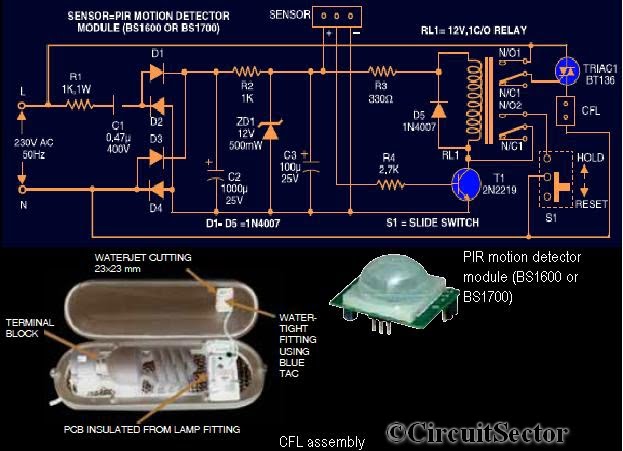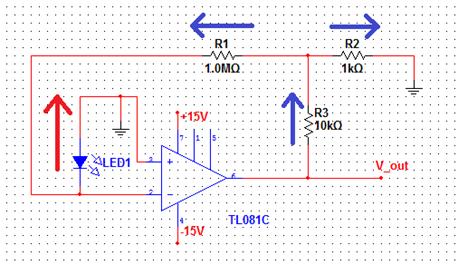
LIGHT SEEKING ROBOT

The circuit is designed to seek light, enabling it to follow a flashlight in a darkened environment. Two photocells are utilized to determine the direction of movement for the robot. Each photocell connects to an operational amplifier (op-amp) configured as a comparator. When sufficient light reaches photocell R2, the voltage at the inverting input (pin 6) of IC1-a drops below the voltage at the non-inverting input (pin 5), causing the comparator's output to go high. This activates transistors Q1 and Q2, which in turn energize relays RY1 and RY2, supplying power to the right motor and prompting the robot to turn left. Conversely, when light on photocell R3 reduces its resistance, transistors Q2 and Q3 activate, energizing the left motor and directing the robot to turn right.
The light-seeking circuit employs a pair of photocells (R2 and R3) that serve as light sensors. These photocells are critical for detecting the intensity of light in their respective directions. The op-amps are configured as comparators to compare the voltage levels from the photocells. When one photocell detects more light than the other, it generates a differential voltage that triggers the appropriate action.
In this setup, the operational amplifier IC1-a plays a pivotal role. It is powered by a suitable voltage supply and has its inverting and non-inverting inputs connected to the photocells. The output of the op-amp drives the base of the transistors Q1 and Q2, which are configured as switches. When the output of the op-amp goes high, it allows current to flow through the transistors, activating the relays RY1 and RY2.
Relays RY1 and RY2 are used to control the power supplied to the motors. When RY1 is activated, it powers the right motor, causing the robot to turn left. Conversely, when RY2 is activated, it powers the left motor, resulting in a right turn. This mechanism allows the robot to navigate towards the light source effectively.
The circuit may also include additional components such as resistors and capacitors to stabilize the operation of the op-amps and transistors, ensuring reliable performance. The design can be further enhanced with features such as adjustable sensitivity for the photocells or feedback mechanisms to improve the robot's directional accuracy. Overall, this light-seeking circuit exemplifies a simple yet effective approach to autonomous navigation based on light detection.The circuit is light seeking; it will follow a flashlight around a darkened room. A pair of photocells determine the direction in which the robot will move. Each photocell is connected to an op amp configured as a comparator. When sufficient light falls on photocell R2, the voltage at the inverting input (pin 6) of ICl-a will fall below the voltag e at the non-inverting input (pin 5), so the output of the comparator will go high, and transistors Q1 and Q2 will turn on. That will enable relays RY1 and RY2, and thereby provide power for the right motor. The robot will then turn left. Likewise, when light falling on R3 lowers its resistance, Q2 and Q3 will turn on, the left motor will energize, and the robot will turn right.
🔗 External reference
The light-seeking circuit employs a pair of photocells (R2 and R3) that serve as light sensors. These photocells are critical for detecting the intensity of light in their respective directions. The op-amps are configured as comparators to compare the voltage levels from the photocells. When one photocell detects more light than the other, it generates a differential voltage that triggers the appropriate action.
In this setup, the operational amplifier IC1-a plays a pivotal role. It is powered by a suitable voltage supply and has its inverting and non-inverting inputs connected to the photocells. The output of the op-amp drives the base of the transistors Q1 and Q2, which are configured as switches. When the output of the op-amp goes high, it allows current to flow through the transistors, activating the relays RY1 and RY2.
Relays RY1 and RY2 are used to control the power supplied to the motors. When RY1 is activated, it powers the right motor, causing the robot to turn left. Conversely, when RY2 is activated, it powers the left motor, resulting in a right turn. This mechanism allows the robot to navigate towards the light source effectively.
The circuit may also include additional components such as resistors and capacitors to stabilize the operation of the op-amps and transistors, ensuring reliable performance. The design can be further enhanced with features such as adjustable sensitivity for the photocells or feedback mechanisms to improve the robot's directional accuracy. Overall, this light-seeking circuit exemplifies a simple yet effective approach to autonomous navigation based on light detection.The circuit is light seeking; it will follow a flashlight around a darkened room. A pair of photocells determine the direction in which the robot will move. Each photocell is connected to an op amp configured as a comparator. When sufficient light falls on photocell R2, the voltage at the inverting input (pin 6) of ICl-a will fall below the voltag e at the non-inverting input (pin 5), so the output of the comparator will go high, and transistors Q1 and Q2 will turn on. That will enable relays RY1 and RY2, and thereby provide power for the right motor. The robot will then turn left. Likewise, when light falling on R3 lowers its resistance, Q2 and Q3 will turn on, the left motor will energize, and the robot will turn right.
🔗 External reference
Warning: include(partials/cookie-banner.php): Failed to open stream: Permission denied in /var/www/html/nextgr/view-circuit.php on line 713
Warning: include(): Failed opening 'partials/cookie-banner.php' for inclusion (include_path='.:/usr/share/php') in /var/www/html/nextgr/view-circuit.php on line 713





